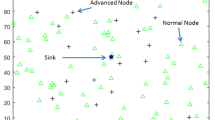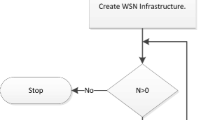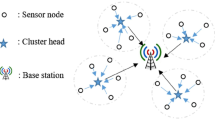Abstract
The topology management classifiers consist of several methods, such as the typical clustering-based method excelled in wireless network partitioning. However, most algorithms appear load unbalanced in the application of irregular network, resulting “energy hot zone” phenomenon. This paper proposes an improved intelligent clustering algorithm and applies it to the complex water system environment. Firstly, we build a new energy consumption model for wireless transmission network, and design a genetic clustering strategy via the minimum energy consumption principle. Secondly, we introduce the P matrix coding approach considering the search scale, so as to avoid the squared increasing relationship between the searching space and the data calculation. Thirdly, we employ adaptive genetic operator to enhance the directivity of the searching space, and utilize a fuzzy modified operator to enhance the accuracy of the cluster head selection, which may ensure the iterative efficiency. Through numerical simulations, empirical results show better performance than traditional methods in load balancing and clustering efficiency, which can effectively improve the network convergence speed and extend the network lifetime.










Similar content being viewed by others
References
Singh, K. (2015). WSN leach based protocols: A structural analysis. In 2015 international conference and workshop on computing and communication (IEMCON), IEEE (pp. 1–7).
Heinzelman, W. R., Chandrakasan, A., & Balakrishnan, H. (2000). Energy-efficient communication protocol for wireless microsensor networks. In Proceedings of the 33rd annual Hawaii international conference on system sciences (p. 10). IEEE.
Cho, C. Y., Lin, C. W., & Wang, J. S. (2008). Reliable grouping GAF algorithm using hexagonal virtual cell structure. In 2008 3rd international conference on sensing technology (pp. 600–603). IEEE.
Younis, O., & Fahmy, S. (2004). Heed: A hybrid, energy-efficient, distributed clustering approach for ad hoc sensor networks. IEEE Transactions on Mobile Computing, 4, 366–379.
Jiang, B., Xue, X. q., & Sha, T. t. (2014). A topology control algorithm for ribbon wireless sensor network. In 2014 IEEE workshop on advanced research and technology in industry applications (WARTIA) (pp. 195–198). IEEE.
Mir, Z. H., & Ko, Y. B. (2017). Collaborative topology control for many-to-one communications in wireless sensor networks. IEEE Access, 5, 15927–15941.
Cui, C., Sun, Y., Lu, J., & Jh, H. A. O. (2016). Research on a hexagonal lattice optimal clustering routing algorithm based on hybrid cs for wsn. Journal on Communications, 37(5), 2016104.
Lv, Y., Jiang, N., Xue, C., & Qiu, K. (2017). Energy-efficient and survivable optical access network based on multilayer-ring structure. IEEE Photonics Journal, 9(4), 1–19.
Serikawa, S., & Lu, H. (2014). Underwater image dehazing using joint trilateral filter. Computers & Electrical Engineering, 40(1), 41–50.
Lu, H., Li, Y., Mu, S., Wang, D., Kim, H., & Serikawa, S. (2017). Motor anomaly detection for unmanned aerial vehicles using reinforcement learning. IEEE Internet of Things Journal, 5(4), 2315–2322.
Lu, H., Li, Y., Chen, M., Kim, H., & Serikawa, S. (2018a). Brain intelligence: Go beyond artificial intelligence. Mobile Networks and Applications, 23(2), 368–375.
Lu, H., Li, Y., Uemura, T., Kim, H., & Serikawa, S. (2018b). Low illumination underwater light field images reconstruction using deep convolutional neural networks. Future Generation Computer Systems, 82, 142–148.
Lu, H., Wang, D., Li, Y., Li, J., Li, X., Kim, H., Serikawa, S., & Humar, I. (2019). Conet: A cognitive ocean network. arXiv preprint arXiv:190106253.
Xu, X., Lu, H., Song, J., Yang, Y., Shen, H. T., & Li, X. (2019). Ternary adversarial networks with self-supervision for zero-shot cross-modal retrieval. IEEE Transactions on Cybernetics. https://doi.org/10.1109/TCYB.2019.2928180.
Lu, H., Liu, Q., Tian, D., Li, Y., Kim, H., & Serikawa, S. (2019a). The cognitive internet of vehicles for autonomous driving. IEEE Network, 33(3), 65–73.
Gajjar, S., Sarkar, M., & Dasgupta, K. (2016). Famacrow: Fuzzy and ant colony optimization based combined mac, routing, and unequal clustering cross-layer protocol for wireless sensor networks. Applied Soft Computing, 43, 235–247.
Garg, N., & Saxena, S. (2018). Cluster head selection using genetic algorithm in hierarchical clustered sensor network. In 2018 second international conference on intelligent computing and control systems (ICICCS) (pp. 511–515). IEEE.
Chang-Ri, L., Yun, Z., Xin-hua, Z., & Zi-bo, Z. (2010). A clustering algorithm based on cell combination for wireless sensor networks. In 2010 second international workshop on education technology and computer science (vol. 2, pp. 74–77). IEEE.
Li, H., Xiong, Q., Shi, W., Chen, H., Du, M., & Ran, Y. (2014). Mechanism of immune system based clustering topology control algorithm in wireless sensor networks. Information Technology Journal, 13(1), 42–50.
Xu, X., He, L., Lu, H., Gao, L., & Ji, Y. (2019a). Deep adversarial metric learning for cross-modal retrieval. World Wide Web, 22(2), 657–672.
Xu, X., Shen, F., Yang, Y., Shen, H. T., & Li, X. (2017). Learning discriminative binary codes for large-scale cross-modal retrieval. IEEE Transactions on Image Processing, 26(5), 2494–2507.
Xu, X., He, L., Shimada, A., & Taniguchi Ri, Lu H. (2016). Learning unified binary codes for cross-modal retrieval via latent semantic hashing. Neurocomputing, 213, 191–203.
Tiwari, T., Roy NR. (2015). Modified deec: A varying power level based clustering technique for WSNs. In 2015 international conference on computer and computational sciences (ICCCS) (pp. 170–176). IEEE.
Shaji, M., Ajith S. (2015). Distributed energy efficient heterogeneous clustering in wireless sensor network. In 2015 fifth international conference on advances in computing and communications (ICACC) (pp. 130–134). IEEE.
kele-Turgut, Abas, & Hafif, O. G. (2016). Nodic: A novel distributed clustering routing protocol in wsns by using a time-sharing approach for ch election. Wireless Networks, 22(3), 1023–1034.
Acknowledgements
This paper is sponsored by Key Research and Development Program of Shaanxi province in 2017 (NO.2017GY-085).This paper is sponsored by National Natural Science Foundation of China (NO.61906086).
Author information
Authors and Affiliations
Corresponding author
Ethics declarations
Conflict of interest
We declare that we have no financial and personal relationships with other people or organizations that can inappropriately influence our work, there is no professional or other personal interest of any nature or kind in any product, service and/or company that could be construed as influencing the position presented in, or the review of this manuscript.
Additional information
Publisher's Note
Springer Nature remains neutral with regard to jurisdictional claims in published maps and institutional affiliations.
Rights and permissions
About this article
Cite this article
Hua, X., Dong, Z., Yao, H. et al. An improved intelligent clustering algorithm for irregular wireless network. Wireless Netw 28, 949–963 (2022). https://doi.org/10.1007/s11276-019-02217-x
Published:
Issue Date:
DOI: https://doi.org/10.1007/s11276-019-02217-x




